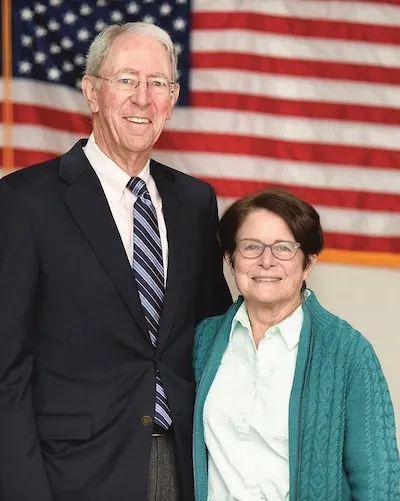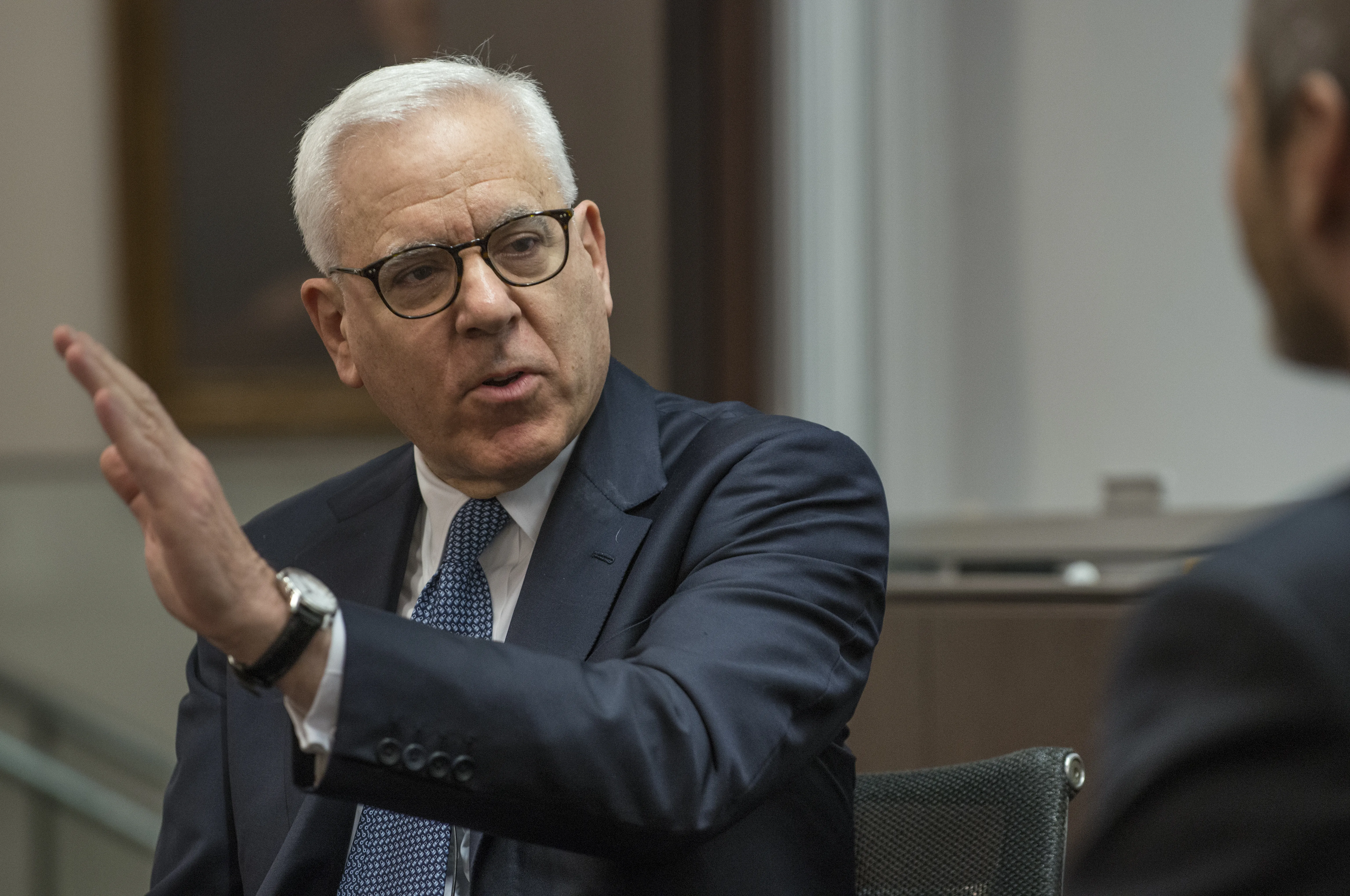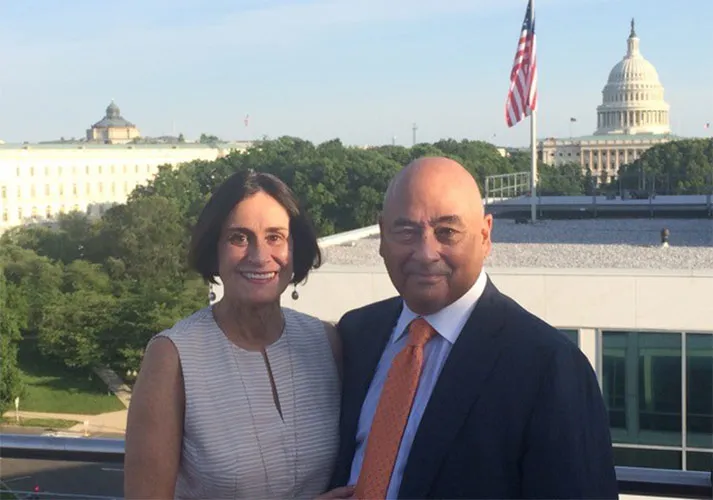Wolf Family Challenge Increases Class Gifts and Class Unity
If you could make a modest financial contribution that would help ensure that Dick Badger got hit with in the face with a pie (with his consent, of course) or that Martha Nussbaum would attend Wine Mess dressed as the goddess Athena, would you do that?
Students from the JD and LLM classes of 2015 arranged those events, and several more, as they raised money for their class gift. Each event was triggered by the achievement of a new level of participation by their classmates. “The way that the faculty and administration pitched in inspired us as a committee, and it certainly caught and sustained our classmates’ interest throughout the fundraising process,” says Paige Braddy, ’15, who cochaired her class’s gift campaign.
A big added financial incentive also encouraged giving. Through a fund created by Chuck Wolf, ’75, his son Pete Wolf, ’10, and Pete’s wife Erin Wagner Wolf, ’10, the Law School offered to add $40,000 to the class’s gift if 76 percent of the class’s students gave something toward the campaign. Blair Bradford, ’15, the committee’s giving chair, says that the Wolf Family Challenge was a powerful motivator. “Knowing that even a small personal contribution could help bring about a much larger class gift definitely won over more than a few of our classmates,” she says.
Elevating participation helps the Law School in a larger way than just boosting the class gift: there is strong evidence that giving while a student leads to a much greater likelihood of giving in the years shortly after graduation, and giving in those early postgraduation years contributes to more giving over the long run.

At 70% participation, Dean Richard Badger good-naturedly takes a pie in the face at the Graduation Wine Mess.
Chuck Wolf says: “We like to support the Law School in whatever way will do the most good. When Daren Batke, in the Law School’s development office, suggested this challenge, we liked it right away, because it has an immediate effect on giving and it also has two cumulative effects, influencing later individual giving and also promoting a sense of class unity that can have a sizable effect on subsequent reunion gifts—reunion gifts that create scholarships, support faculty, improve facilities, and do lots of other things to help keep the Law School great.”
2015 was the third year that the Wolf Family Challenge was in effect. The 76 percent goal for the class of 2015 was 1 percent higher than the participation level reached by the class of 2014. That class received $30,000 for reaching its goal, and the class of 2013 earned $25,000 for exceeding 70 percent participation. The class of 2015 substantially exceeded its challenge goal, reaching 86 percent participation.
Outdoing previous classes was a driving force for the campaigns. 2014 cochair Christine Ricardo observes: “Chicago law students are just wired to respond to challenges. Set a standard and we’ll try to beat it. We told ourselves that we were at least as creative, interesting, and energetic as the 2013 class, so with some effort we ought to be able to do better than them.”
Individuals’ contributions can be designated for application to the general fund, or for faculty, scholarships, or clinics, and a portion of the funds that are raised is used for a tangible gift. The 2014 and 2015 gifts were poignant—benches in the Law School’s garden in memory of deceased classmates Laura LaPlante, ’14, Jay Brooks, ’15, and Abbie Harper, ’15. 2014 LLM chair Mishita Jethi reflects: “Laura’s death was tragic, but we took some solace from knowing that because of the garden bench dedicated to her, she will still be remembered many years from now. We were glad to use part of our gift in that way, as a lasting remembrance from all 2014 graduates. It was moving to join together for that purpose.”
Grassroots canvassing was a vital part of each class’s strategy. 2013 cochair Matea Bozja reports: “The members of our committee met individually with almost every classmate at least once to make a personal appeal. We caught people in the Green Lounge or in class, we sent individual emails—we did whatever was necessary to be sure we reached everyone. Even those who didn’t give got the message, and I think that will affect their likelihood of giving in the future.”
For the LLM graduates, there was another mobilizing factor, as 2015 LLM chair Thibault De Boulle explains: “Many of us come from countries in which philanthropy isn’t as crucial for academic institutions as it is in the US, and many of us received scholarships. So we came to see the importance of giving and the direct connection between giving and opportunities for ourselves and for future LLMs.” LLM participation has outpaced JD participation in each of the three years: 85 percent in 2013 and 2014, and 89 percent this year.
“It’s been wonderful to see each class surpassing what the previous one achieved, having fun while they put in that effort, educating their classmates about the importance of giving, and helping to create a habit of giving that will have very substantial long-term benefits for the school that means so much to so many of us,” Pete Wolf says. “Even something close to 100 percent participation seems like it might be within reach in the future, and that’s an exciting prospect that is more than our family ever thought might happen when we funded this challenge.”
Chuck Wolf adds, “It has been very nice for Pete, Erin, and me to fund this challenge as a family entity and to share in the energy that it helps create. I think more families might want to consider some kind of shared involvement.”


